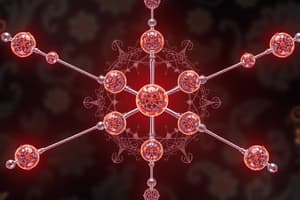Podcast
Questions and Answers
What does the Lewis structure for Carbon dioxide look like?
What does the Lewis structure for Carbon dioxide look like?
The Lewis structure for Carbon dioxide shows a central carbon atom double bonded to two oxygen atoms, with each oxygen having two lone pairs.
What is the electron-dot diagram for Br₂ (l)?
What is the electron-dot diagram for Br₂ (l)?
The electron-dot diagram for Br₂ shows two bromine atoms bonded together with a shared pair of electrons and three lone pairs on each bromine.
What is the correct Lewis dot structure for Sodium chloride?
What is the correct Lewis dot structure for Sodium chloride?
The Lewis dot structure for Sodium chloride shows a sodium ion with no dots and a chloride ion with eight dots around it, indicating a transfer of an electron.
Lewis structure of HCN looks like...
Lewis structure of HCN looks like...
What is the Lewis Dot Structure?
What is the Lewis Dot Structure?
What is the octet rule?
What is the octet rule?
Lewis dot structures for ionic bonds...
Lewis dot structures for ionic bonds...
Lewis dot structures for covalent bonds...
Lewis dot structures for covalent bonds...
Alkaline earth metals have how many valence electrons?
Alkaline earth metals have how many valence electrons?
Group 14 has how many valence electrons?
Group 14 has how many valence electrons?
Halogens have how many valence electrons?
Halogens have how many valence electrons?
Noble gases have how many valence electrons?
Noble gases have how many valence electrons?
Flashcards are hidden until you start studying
Study Notes
Lewis Structures
- Carbon dioxide (CO₂) has a Lewis structure showing two double bonds between carbon and oxygen atoms.
- The electron-dot diagram for bromine (Br₂) illustrates two Br atoms sharing a pair of valence electrons, depicted with dots around each atom.
Ionic and Covalent Bonds
- Sodium chloride (NaCl) has a Lewis dot structure that illustrates sodium losing an electron and chlorine gaining one, represented with brackets and charges.
- Lewis dot structures for ionic bonds include brackets and indicate charge due to electron transfer between atoms.
Covalent Bonding
- Lewis dot structures for covalent bonds demonstrate shared pairs of valence electrons, which visually represent how atoms bond by sharing electrons.
Valence Electrons
- Alkaline earth metals possess two valence electrons, crucial for their reactivity.
- Group 14 elements have four valence electrons, enabling diverse bonding behavior.
- Halogens have seven valence electrons, making them highly reactive as they seek to gain one more electron.
- Noble gases have eight valence electrons, which grants them stable electron configurations and non-reactivity under normal conditions.
Key Concepts
- A Lewis dot structure is a visual representation of a molecule using dots to signify valence electrons.
- The octet rule states that atoms strive for eight valence electrons to achieve stability akin to noble gases.
Studying That Suits You
Use AI to generate personalized quizzes and flashcards to suit your learning preferences.




